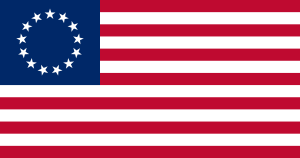Flag Acts facts for kids
The Flag Acts are three important laws that helped decide what the United States flag looks like. These laws were created a long time ago to make sure everyone knew what the national flag should be.
Contents
Flag Act of 1777
The Flag Act of 1777 was passed by the Continental Congress on June 14, 1777. This happened after a Native American group asked for an "American Flag." Because of this important law, June 14 is now celebrated every year as Flag Day in the United States.
What the 1777 Act Said
This law clearly stated what the first official flag should look like:
Resolved, That the flag of the thirteen United States be thirteen stripes, alternate red and white; that the union be thirteen stars, white in a blue field, representing a new constellation.
In simpler words, this meant:
- The flag should have 13 stripes.
- These stripes should be red and white, one after the other.
- The flag should have 13 white stars on a blue background.
- These stars would represent a "new constellation," meaning a new group of states joining together.
Flag Act of 1794
The Flag Act of 1794 was signed into law by President George Washington on January 13, 1794. This law changed the flag's design. It was updated because new states, Vermont and Kentucky, had joined the United States.
This act made the flag have 15 stripes instead of 13. It also increased the number of stars to 15. This was the only official US flag that did not have 13 stripes.
What the 1794 Act Said
Here is what the law stated:
An Act making an alteration in the Flag of the United States.
Be it enacted by the Senate and House of Representatives of the United States of America in Congress Assembled, That from and after the first day of May, Anno Domini, one thousand seven hundred and ninety-five, the flag of the United States, be fifteen stripes alternate red and white. That the Union be fifteen stars, white in a blue field.
This means that starting from May 1, 1795, the flag would have 15 red and white stripes. It would also have 15 white stars on a blue background.
Flag Act of 1818
The Flag Act of 1818 was passed by Congress on April 4, 1818. This law set the rules for the flag that we still mostly follow today. It brought back the original 13 stripes. It also made sure that the number of stars on the flag would always match the current number of states in the country.
This act also decided that any new stars added to the flag would be added on July 4th, which is Independence Day.
Before this act, between 1794 and 1818, there were no official US flags with 16, 17, 18, or 19 stars. This was because no new flag laws were made when more states joined the country during that time.
What the 1818 Act Said
This is what the law declared:
An Act to establish the flag of the United States.
Be it enacted by the Senate and House of Representatives of the United States of America, in Congress Assembled, That from and after the fourth day of July next, the flag of the United States be thirteen horizontal stripes, alternate red and white: that the union be twenty stars, white in a blue field.
And be it further enacted, That on the admission of every new state into the Union, one star be added to the union of the flag; and that such addition shall take effect of the fourth day of July then next succeeding such admission.
This means that from July 4, 1818, the flag would have 13 red and white stripes. It would also have 20 white stars on a blue background. The law also said that whenever a new state joined the country, one more star would be added to the flag. This new star would be added on the next July 4th after the state joined.




